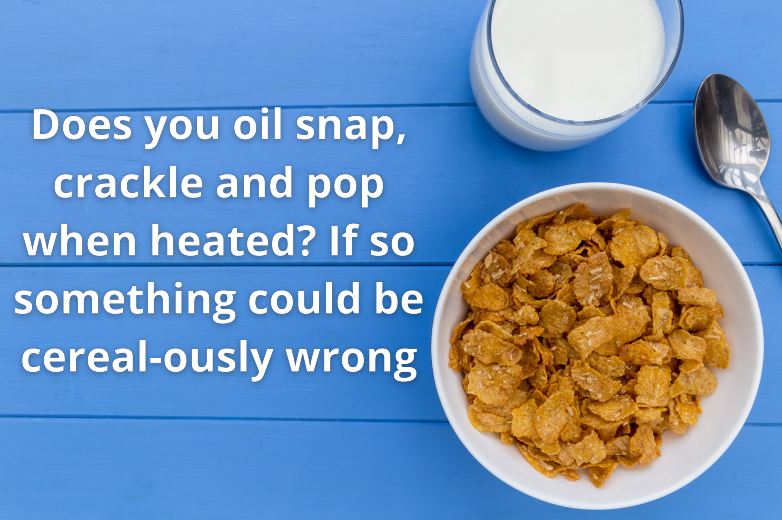Were you ever told in your high school science class that oil and water don’t mix? Sorry to be the bearer of bad news but this ‘fact’ is not always true. In many cases, if you try to mix oil and water (an experiment I’ve tried with my curious 3-year-old on a few occasions) the oil will float to the top as it is less dense than water, creating a distinctive layered look. You may have seen photos on the news after major oil spills at sea showing a black oily puddle floating on the water. However, under certain circumstances, oil and water can and do mix; at least at low levels. This article will discuss how this occurs and why your oil should never ever snap, crackle or pop.
Water is all around us so it is inevitable that some of it will find its way into the machinery we use. A low level of water in your lubrication oil is completely normal and oil companies and OEMs factor this in when creating products. Engine oils commonly have detergent additives in them that act as emulsifiers; This is so that a normal low level of water in the engine (a product of combustion) will be dispersed into the oil reducing the harm. However, on occasion, the levels of water will become too high due to factors like coolant leaks, heavy condensation or environmental ingress. When this level becomes too high, the additives struggle to handle it leading to the oil-water separation that we know about.
If your oil sample arrives at the lab with a distinctive layered look, our staff can easily see that a high volume of water is present meaning something is seriously wrong with the sample. However, you may wonder what happens when a sample comes in containing an abnormal water level but looks fine thanks to the power of the emulsifying additives, which can suspend the water up to sometimes 5,000ppm (0.5%). Speciality lubricants including fire-resistant fluids can do this to much higher levels (read the box below for more info).
Can high water ever be normal?
In short, yes in certain circumstances. High water can also be present in glycol based oils (termed water glycols) that mix very well with water and can have anywhere between 30% and 60% water. Equally, emulsion fluids used in metal working and other soluble lubricants can also have much higher finely dissolved water particles. Both these lubricants with higher water contents are used in both metal working and as fire resistant fluids and it can be normal to have over 50% water in some of these fluids depending on the specification of the fluid. However, for most other lubricants water is indeed not supposed to be there and is a contaminant that should be carefully managed.
Every oil sample that comes through our doors is given a hotplate crackle test as standard to detect whether there is a high level of water present. This test is performed by dropping a small amount of oil onto a hotplate heated to >250’C, although some labs only heat to 160’C, but do risk not detecting the water if they do. The reason for this is you need to quickly convert the water to gas to make a crackling sound, so only heating a little above 100’C gently boils the water and means it may not give a strong crackle sound or bubbling appearance. If a sample doesn’t bubble or crackle, it means that any water present is below detectable levels (usually <0.1%) and therefore also normal for most lubricants. If the sample bubbles, spits, crackles or pops like your favourite breakfast cereal, then an abnormal amount of water is present. If this happens, we next need to detect just how much water is in the sample so it is taken for a hydride test. This involves weighing into a test tube, adding calcium hydride and measuring the volume of hydrogen gas generated as it reacts with water. Depending on the volume of water present the lab may decide to test using other methods including Karl Fisher, thermogravimetric analysis and distillation analysis (often called Dean and Stark).
Many people assume the lab just push a few buttons and the analysis is complete, but there are often 40+ tests performed on each sample and this is just one of them. To find out more about our analysis then get in touch with us using the contact link on the bottom right of this screen.
PS. For those of you who noticed that I used flakes in my term for another famous cereal brand this is because I couldn’t get a stock photo of that particular cereal, but for those with your observant eye let us know the brand of cereal we were referring to and you will get free UK delivery on your first order of sample bottles.
Author: Katie @ Learn Oil Analysis . com foundation.


